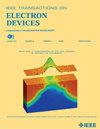Giant Tunneling Electroresistance in 2-D In-Plane Ferroelectric Tunnel Junctions Based on a α -In₂Se₃/Cd₃C₂ Heterostructure
IF 2.9
2区 工程技术
Q2 ENGINEERING, ELECTRICAL & ELECTRONIC
引用次数: 0
Abstract
Ferroelectric tunnel junctions (FTJs), composed of two metallic or semiconductor leads separated by a thin ferroelectric tunnel barrier, demonstrate significant potential for nonvolatile memory devices. With the development of device miniaturization, 2-D FTJs have attracted increasing attention due to the unique characteristics of material stability, atomic thickness, and high tunnel electroresistance (TER) ratio. In this work, a 2-D in-plane van der Waals (vdW) FTJ constructed using a In2Se3/Cd3C2 heterostructure is designed, and its electron transport properties have been investigated based on density functional calculations combined with a nonequilibrium Green’s function (NEGF) technique. The results demonstrate that a TER ratio of 106% is achieved due to the change from Schottky- to Ohmic-type contact at the In2Se3/Cd3C2 interface accompanied by ferroelectric polarization reversal. Meanwhile, the current-voltage (I–V) characteristics at low bias voltages indicate significant amplitude differences between currents under different polarization states. The TER can be stably maintained above 106%, indicating two ideal states “0” and “1” for data storage. The mechanism for the Schottky to Ohmic switching is explained by different charge transfers between the contacted surfaces of the two materials under different polarization directions, which are further controlled by the work functions of them. Consequently, work function engineering offers a promising method for constructing 2-D ferroelectric vdW heterostructures and FTJs, which has promising application potential in nanoscale high-density ferroelectric memory devices.基于 α -In₂Se₃/Cd₃C₂ 异质结构的二维平面内铁电隧道结中的巨隧道电阻
铁电隧道结(FTJ)由两根金属或半导体导线组成,中间隔着一层薄薄的铁电隧道势垒。随着器件微型化的发展,二维 FTJ 因其独特的材料稳定性、原子厚度和高隧道电阻(TER)比等特性而受到越来越多的关注。本文设计了一种使用 In2Se3/Cd3C2 异质结构构建的二维平面内范德华(vdW)FTJ,并基于密度泛函计算结合非平衡格林函数(NEGF)技术对其电子传输特性进行了研究。结果表明,由于 In2Se3/Cd3C2 界面上的肖特基接触转变为欧姆接触,同时伴随着铁电极化反转,TER 比达到 106%。同时,低偏置电压下的电流电压(I-V)特性表明,不同极化状态下的电流振幅差异显著。TER 可以稳定地保持在 106% 以上,表明数据存储有 "0 "和 "1 "两种理想状态。肖特基到欧姆开关的机理可解释为两种材料的接触表面在不同极化方向上的电荷转移不同,而电荷转移又进一步受控于它们的功函数。因此,功函数工程为构建二维铁电 vdW 异质结构和 FTJ 提供了一种可行的方法,在纳米级高密度铁电存储器件中具有广阔的应用前景。
本文章由计算机程序翻译,如有差异,请以英文原文为准。
求助全文
约1分钟内获得全文
求助全文
来源期刊

IEEE Transactions on Electron Devices
工程技术-工程:电子与电气
CiteScore
5.80
自引率
16.10%
发文量
937
审稿时长
3.8 months
期刊介绍:
IEEE Transactions on Electron Devices publishes original and significant contributions relating to the theory, modeling, design, performance and reliability of electron and ion integrated circuit devices and interconnects, involving insulators, metals, organic materials, micro-plasmas, semiconductors, quantum-effect structures, vacuum devices, and emerging materials with applications in bioelectronics, biomedical electronics, computation, communications, displays, microelectromechanics, imaging, micro-actuators, nanoelectronics, optoelectronics, photovoltaics, power ICs and micro-sensors. Tutorial and review papers on these subjects are also published and occasional special issues appear to present a collection of papers which treat particular areas in more depth and breadth.
 求助内容:
求助内容: 应助结果提醒方式:
应助结果提醒方式:


